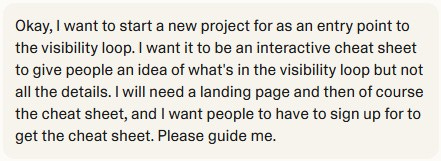I Built a Web App With AI
How I used vibe coding to create a customer-only tool for The Visibility Loop
I wasn’t planning to build software. But after a long conversation with Kim Doyal where she walked me through web apps she was creating with no coding experience required, I had to try it.
After noodling around and thinking about a simple project I could create, I decided on a cheat sheet for people who had purchased The Visibility Loop to help them implement the steps in the program.
So they wouldn’t have to scroll back through emails or dig through folders. Simply click a link to view a checklist of the 10-day program's steps laid out clearly. One place. Easy to bookmark. Easy to keep going.
That’s how the interactive cheat sheet was born.
And I built it using a relatively new method called vibe coding.
Vibe coding is a new approach to software development that centers on using artificial intelligence (AI) tools—especially large language models (LLMs)—to generate code from natural language descriptions, rather than manually writing every line yourself. The term was popularized by Andrej Karpathy, a prominent computer scientist and former Tesla AI director, in early 2025. (source)
If that sounds technical, here’s what it looked like for me:
I wrote or spoke plain language prompts with Wispr Flow.
I asked for what I wanted.
I revised based on what came back.
And step by step, the cheat sheet took shape.
All I used was Lovable, ChatGPT, and Supabase. No traditional coding. No dev team.
What I built with Lovable
There are two parts:
A landing page with a call to action and email signup
A private, interactive cheat sheet organized by the 10-day Visibility Loop framework
When someone buys the program, they get access to the cheat sheet. It’s designed to work like a hub. Each day opens into an expandable card. There are reminders, quick tips, and buttons to access bonus resources like the Visibility Edge Alliance and the custom GPT assistant trained on the Visibility Loop program.
It works on mobile and desktop. It looks and feels like my brand. And it came together in 6 days.

Why I made this
Most digital products focus on the lead-up: the sales page, the launch, the list growth.
Taking action and implementation is something I focus on a lot with my clients.
Having a simple tool to track their progress seemed like something I could create.
If they’re excited on day one but forget where to go on day three, then all that good content just sits there.
This cheat sheet helps people keep going.
And that’s what makes it a good visibility tool.
Ideas not coupled with action never become bigger than the brain cells they occupied. – Arnold H. Glasow
When your customers can apply what they've bought from you, they achieve better results. When they share those results, other people notice. That builds trust. That leads to referrals.
How vibe coding made it possible
Lovable helped me develop the visual framework. That set me up to better articulate the look and feel, and the underlying tech that made it work.
The copy was primarily derived from the content I had previously created for the program. Supabase handled the signup flow and private access.
My prompting was done primarily verbally with Wispr Flow.

I didn’t map out the whole thing at once. I asked for what I wanted, step by step. And when something didn’t work, I asked for a fix. That was the flow.
What surprised me most was how natural it felt. Once I could describe the experience I wanted to create, the tools did the heavy lifting within 1-2 minutes.
If you're curious to try vibe coding
Think of one piece of your product or program that’s hard to follow through on. Something people want to use, but don’t always finish.
Now, imagine turning that into a simple tool they can bookmark and come back to. It doesn’t have to be fancy. It just has to help them keep going.
If you’ve never worked with AI this way before, start small.
Start by describing what you want. That’s the first step of vibe coding.
You don’t need to write code. You don’t need to write or speak clearly.
And if you want to see what it looks like in real life, The Visibility Loop cheat sheet is live and working. Everyone who buys gets access.
This was an experiment. And it’s one I’ll be repeating.
I have a long way to go towards mastering vibe coding. This project inspires me to experiment with more ideas.
I gave a demo of this process to members of the AI Success Club. They were blown away. A couple of people jumped on Lovable during the call (free version includes 5 prompts per day) and immediately created prototypes for ideas they had.
Got questions about my process? Ask in the comment thread 👇
P.S. Be sure to follow and subscribe to Kim Doyal’s Substack. She’s way ahead of me on this adventure and is sharing her experiences.








Thank you, Denise, and OMG! Brilliant idea on Notebook LM! I can't wait to jump into that and follow that process.